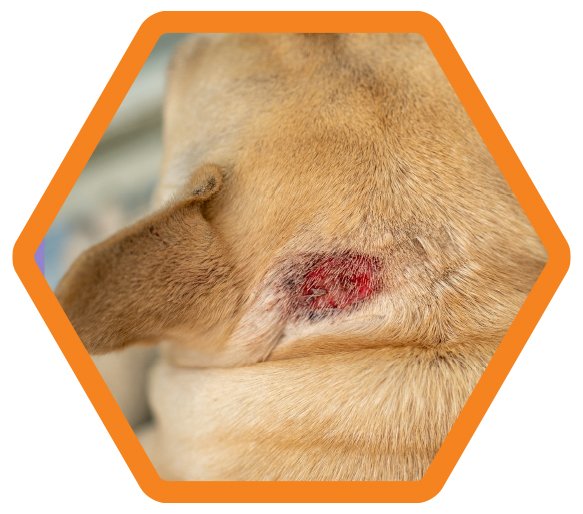Hot Spots – And How to Treat Them!
Hot spots are one of the most common types of skin infections in dogs, but other types of animals can get them too, especially during the summertime! Also known as acute moist dermatitis or “summer sores,” they can be difficult to heal on their own. It is important to know how to recognize hot spots and learn how to treat them!
What is a Hot Spot?
Hot spots are hot, inflamed skin lesions that can appear suddenly and spread rapidly. The bacteria that builds up within the hot spot can spread to other parts of the body. It can be discomforting to your animal and causes them to continuously lick, scratch, and bite the area. This self-trauma creates a cycle of never-ending itchiness.
A hot spot on the back of a dog’s head.
It can be hard to recognize a hot spot because they can easily be mistaken for insect bites. They may start off small, but will quickly turn into a large, hot, red lesion. Hot spots are most commonly found on the head, legs, or hips, but can appear anywhere on the body. Unfortunately, not all hot spots can be easily spotted as some hide under matted fur. They can be painful and itchy, so your pet may be uncomfortable. If you think you found a hot spot on your pet, contact your veterinarian.
What Causes Hot Spots?
Hot spots are usually triggered by self-trauma. Animals irritate the lesion to the point that it creates an open wound. The repeated licking, scratching, and biting on the body is caused by many things like allergies, matted coats, ear infections, insect bites, stress, and even boredom.
Dogs that frequently are wet from swimming and bathing are more likely to develop hot spots from the excess moisture being held in their fur. Other animals can get them, but they are mostly seen in dog breeds that have thicker coats like Golden Retrievers and St. Bernards.
How to Treat Them!
If you see your animal has a hot spot, the first thing you want to do is stop them from touching the area and contact your veterinarian. The most important thing is to try and prevent a deeper skin infection. Prescribed medication may be needed, but using HoneyCure can help minimize discomfort and scarring during the healing process.
HoneyCure helps to soothe your pet’s skin and can help act as a barrier against germs, dirt, and debris. There is no need to worry about your pet consuming HoneyCure because our unique formula discourages animals from licking, scratching, or biting the affected area because of its unappealing taste and odor. HoneyCure is not intended to be consumed, but if your animal does, it is non-toxic.
How to Prevent Them!
Animals that get hot spots are prone to getting them again. Thankfully, there are measures that you can take to help prevent it from happening!
Frequently grooming and brushing your pet. For pets that swim or bathe often, make sure that their coats are completely dried after.
Boredom and stress can be the cause for your pet’s itching, so increasing daily exercise and play is a great way to keep them mentally stimulated.
Administering a flea preventative. Make sure you give your pet their flea medication once every thirty days.
Underlying issues may cause hot spots to keep appearing, so the most important thing is to identify the cause of your pet’s itching. From early detection and the right management, your pet will heal quickly with no lasting effects!
Reference:
Elizabeth Racine, DVM. “How to Treat and Prevent Hot Spots on Dogs.” American Kennel Club, American Kennel Club, 25 July 2022, https://www.akc.org/expert-advice/health/treating-and-preventing-hot-spots-on-dogs/.
“Hot Spots on Dogs.” Small Door Veterinary, https://www.smalldoorvet.com/learning-center/what-to-do/hot-spot-in-dogs.
Williams, Krista, et al. “Hot Spots in Dogs: VCA Animal Hospital.” Vca, https://vcahospitals.com/know-your-pet/hot-spots-in-dogs#:~:text=What%20is%20a%20hot%20spot,head%2C%20legs%2C%20and%20hips.



